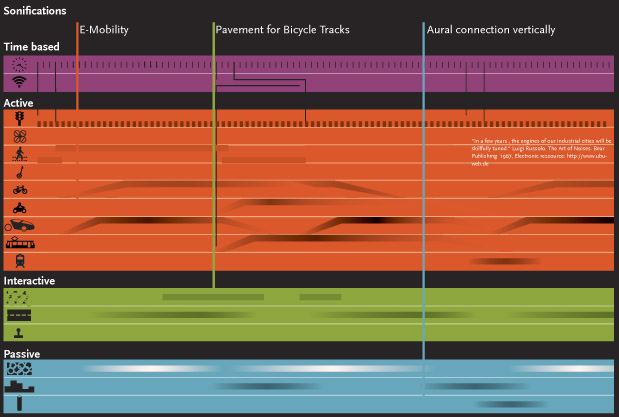KOSMOS SUMMER UNIVERSITY HU BERLIN
Signals of Mobility
When I had been to Egypt about fifteen years ago the dense and seemingly chaotic traffic in the streets in the city of alexandria and moreover cairo was quite fascinating. As a relaxed passenger in a cab i was immersed in – and attentively listening to – the honking of mine and all the other cars drivers that surrounded me. Other than in germany where still today the habit of honking is less a caring warning than a sudden punishing snap to my ears they tooted short, soft and casually. In egypt these sounds seemed to be continuously calling out “I am here”. A voicing what became “Behind you”, “Off-center”, “Beside you” or “Turning away” to the ones that were listening, driving and walking. Neither the colours of traffic lights nor shining uniforms of policemen were authorities enough to rule the traffic in a reliable way. This was finally done by this informal communication system that paralleled and underwent the others mentioned before – I couldn’t imagine the trackless swelling and endless streaming traffic other than that way to be both possible and practicable since then.
Dynamics & Sound
Already in 1913 the futurist luigi russolo had demanded in “The Art of Noises” that the motors and machines in the cities and factories ought to be turned over into an hauntingly beautiful orchestra of noises. His aim for an ideal orchestration of all urban sounds can be seen as an instruction to city planning that even 100 years later has not been accomplished yet. Dynamics and Sound was a search for such forms adapted to current and future needs and possibilities, with a special focus on mobility.
Research Problems and Questions
“How can techniques and strategies of sonification be applied in urban mobility scenarios? What could be the future city sound like and how could it be shaped? These questions whre the starting point for the research team focussing on ‘dynamics and sound’. Traffic for Example as a dynamic system, has aleways been perceived acoustically as well as optically. The sound of an approaching car alerts pedestrians. But what happens if cars will be electro-driven in future and everybody listens to music anyway?”

Research Process and Results
“The participiants especially explored two sets of questions regarding urban mobility and sonification. Firstly they dicussed how traffic could be translated into aural events and, thereby, could be used to support a strategic improvement of constructional planning. Secondly, the team focused on reducing the risks of road users through the use of sonification strategies. The unsconsiousness of aural impressions and perceptions lead the team to develop a system that transforms traffic noise into music in which each road user matches a sound.”

Resume
My personal contribution was to reflect audifications and model based sonifications in a broader context. Their conditions and limits rely directly upon the planning processes and their contents – and the concluding gestalt. In this respect I focus on the research and development of forms of expression in architecture. Specifically for the planning disciplines such developments are essential, as it is already predetermined in their expressions which parameters are being regarded and which are being unconsciously neglected.
